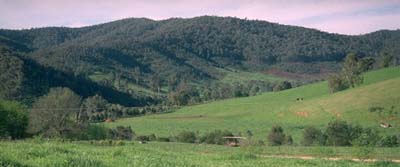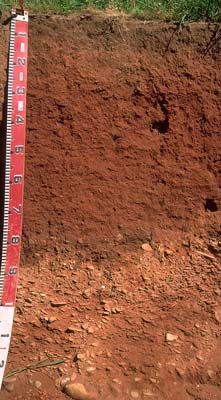NE30
| Group: Tallangatta Valley Landcare Group | Australian Soil Classification: Acidic, Mesotrophic, Red DERMOSOL |
| Northcote Factual Key: Gn3.24 | Great Soil Group: red podzolic |
| Site Description: | |
 NE30 landscape |
Soil Profile Morphology:
Surface Soil
A1 | 0-10 cm | Dark brown (7.5YR3/4); fine sandy clay loam; weak to moderate medium blocky structure; firm consistence dry; pH 4.9; clear change to: |  NE30 profile |
A2 | 10-20 cm | Yellowish red (5YR4/6); fine sandy clay loam; weak medium blocky structure; firm consistence moist; contains a few (5%) alluvial gravels (5 mm average diameter); pH 5.5; clear change to: | |
| Subsoil | |||
B21 | 20-50 cm | Dark red (2.5YR4/7); light clay (fine sandy); moderate medium blocky, breaking down to moderate fine blocky structure; weak consistence moist; contains a few (5%) alluvial gravels (4 mm average diameter); pH 5.1; gradual change to: | |
B22 | 50-75 cm | Dark red (2.5YR4/8); light clay (fine sandy); moderate medium blocky structure; weak consistence moist; contains a common (10%) amount of alluvial gravel (4 mm average diameter); pH 5.3; gradual change to: | |
C | 75-130+ cm | Alluvial gravels. | |
Key Profile Features:
- Moderate texture contrast between surface (A) and subsoil (B) horizons.
- Significant deposits of coarse alluvial gravels at varying depths in the subsoil.
- The soil profile is very strongly acid to strongly acid throughout.
Soil Profile Characteristics:
Horizon | pH | Salinity Rating | ||
Surface (A1 horizon) | very strongly acid | very low | non-sodic | none |
Subsoil (B21 horizon) | strongly acid | very low | non-sodic | none |
Deeper subsoil (50-75 cm) | strongly acid | very low | non-sodic | none |

Horizon | Horizon Depth (cm) | pH (water) | pH (CaCl2) | EC 1:5 | Exchangeable Cations | ||||
Ca | Mg | K | Na | ||||||
meq/100g | |||||||||
A1 | 0-10 | 4.9 | 4.3 | 0.07 | 4.2 | 0.3 | 0.3 | <0.1 | |
B1 | 10-20 | 5.0 | 4.3 | <0.05 | 2.2 | 0.3 | 0.3 | <0.1 | |
B21 | 20-50 | 5.1 | 4.4 | <0.05 | 3.4 | 0.9 | 0.4 | <0.1 | |
B22 | 50-75 | 5.3 | 4.6 | <0.05 | 3.1 | 1 | 0.4 | <0.1 | |
Horizon | Horizon Depth (cm) | Exchangeable Aluminium mg/kg | Field Capacity pF 2.5 | Wilting Point pF 4.2 | Coarse Sand (0.2-2.0 mm) | Fine Sand (0.02-0.2 mm) | Silt (0.002-0.02 mm) | Clay (<0.002 mm) |
A1 | 0-10 | 160 | 33.5 | 11.2 | 11 | 32 | 28 | 23 |
B1 | 10-20 | 170 | 28 | 9.4 | 10 | 36 | 32 | 23 |
B21 | 20-50 | 160 | 31.1 | 13.7 | 7 | 28 | 25 | 40 |
B22 | 50-75 | 130 | 30.6 | 13.1 | 11 | 28 | 25 | 37 |
Management Considerations:
Whole Profile
- Plant available water capacity (PAWC) is considered to be medium (estimated at 105 mm) for this site. This is based on available laboratory data and assumes an effective rooting depth of 9 cm. Rooting depth will be restricted by the coarse alluvial gravels in the subsoil.
- The soil profile will be relatively well drained. The coarse river gravels at depth will also result in free deeper subsoil drainage.
Surface (A) Horizons
- The surface soil is very strongly acid which indicates that aluminium and manganese toxicity may occur. The level of exchangeable aluminium measured in the laboratory (160 mg/kg) suggests that aluminium sensitive species such as lucerne, phalaris and some medics may be affected. Raising the pH level of the surface soil will help reduce the toxic levels of aluminium. Other factors need to be considered, however, before lime is recommended (eg. pasture species grown, method of application, local trial responses, soil surface structure, likely cost/benefits).
- Deficiencies in molybdenum, phosphorus and potassium may occur in the very strongly acid surface soil. Lime application may assist in increasing phosphorus availability. Plant tissue analysis may give a more accurate assessment of molybdenum requirements.
- Exchangeable aluminium levels are similar (170 mg/kg) in the subsurface (A2) horizon.
- The surface soil has a high fine sand (32%) and silt (28%) content. As a result organic matter is important for maintaining soil structure. At low organic matter levels increased slaking will occur which will lead to exacerbated surface sealing and hardsetting. Organic matter would decline if cultivation takes place.
Subsoil (B) Horizons
- The subsoil is strongly acid throughout and exchangeable aluminium levels are still reasonably high (160 mg/kg) which may restrict the growth of aluminium sensitive species. Surface lime application will have negligible effect on subsoil aluminium levels.
- The subsoil has a low inherent nutrient status (based on the sum of the exchangeable basic cations).
- A good plant rooting environment will be provided for aluminium tolerant species as the subsoil is reasonably well structured, has a relatively high exchangeable calcium:magnesium ratio and is well drained.
Notes
Profile described by Mark Imhof, Paul Rampant and Karen De Plater (25/10/95).


